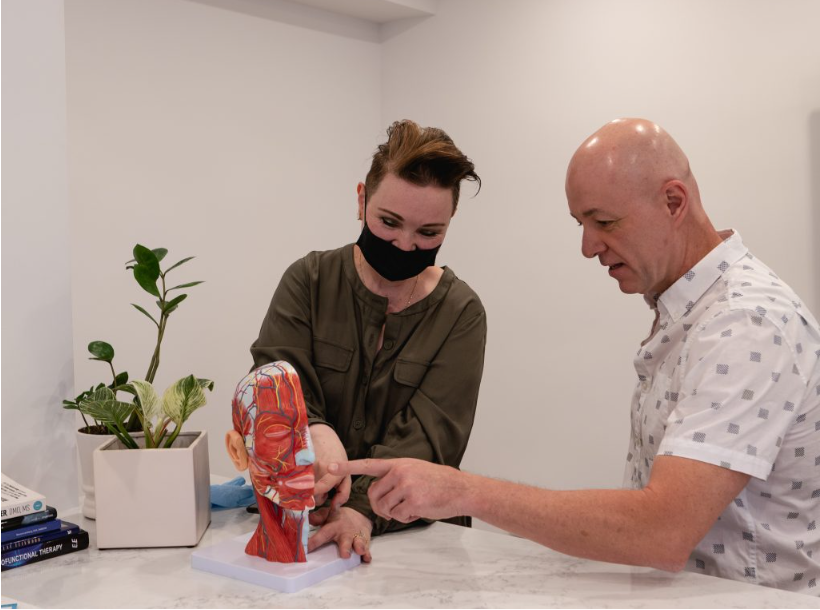Sleep apnea and snoring are two of the most common sleep disorders, affecting millions of people worldwide. Though often dismissed as mere inconveniences, both conditions can have serious long-term effects on health, including fatigue, cardiovascular issues, and impaired cognitive function. While traditional treatments such as CPAP (Continuous Positive Airway Pressure) machines, oral appliances, and surgery are often recommended, an emerging and non-invasive alternative—Myofunctional Orofacial Therapy (MOFT)—is proving to be a valuable tool in managing these disorders. This therapy focuses on retraining the muscles of the face, mouth, and throat to improve airway function, reduce snoring, and address the underlying causes of sleep apnea.
What is Myofunctional Orofacial Therapy?
Myofunctional Orofacial Therapy is a specialized form of therapy that aims to retrain the muscles of the face, mouth, and throat to function properly. It primarily involves exercises designed to correct improper tongue posture, promote nasal breathing, and strengthen the muscles responsible for swallowing and airway control. MOFT is based on the idea that improving the function of these muscles can help maintain an open airway during sleep, reduce snoring, and even alleviate symptoms of sleep apnea.
In the context of sleep apnea and snoring, the primary focus of MOFT is on strengthening the muscles that control the tongue, soft palate, and throat. Weakness or dysfunction in these muscles can contribute to airway obstruction during sleep, leading to both snoring and apneic events. By targeting and training these muscles, Myofunctional Orofacial Therapy aims to address the root causes of these conditions, offering a non-invasive and potentially long-lasting solution.
How Myofunctional Orofacial Therapy Works for Sleep Apnea and Snoring
1. Strengthening the Muscles of the Airway
One of the primary causes of both sleep apnea and snoring is the collapse of the airway during sleep. This typically occurs when the muscles of the tongue, soft palate, and throat become weak or relax too much during sleep, leading to airway obstruction. When the airway becomes blocked, it can cause snoring, breathing pauses (apnea), and other disruptions to sleep.
Myofunctional Orofacial Therapy focuses on strengthening these muscles to prevent collapse and keep the airway open during sleep. Targeted exercises for the tongue and soft palate help improve their tone and coordination, making them more resistant to collapse. For example, exercises that strengthen the tongue muscles can help prevent the tongue from falling back into the throat during sleep, which is a common cause of airway obstruction.
2. Promoting Nasal Breathing
Mouth breathing is another common contributor to snoring and sleep apnea. When individuals breathe through their mouths, the airway becomes less stable, which can increase the likelihood of snoring and airway obstruction. Additionally, mouth breathing leads to dry mouth, which can exacerbate snoring and increase the risk of infections and other oral health issues.
Myofunctional Orofacial Therapy emphasizes the importance of nasal breathing. Through exercises that promote nasal breathing, individuals can learn to keep their mouths closed and breathe through their nose both during the day and at night. Nasal breathing helps to humidify and filter the air, which can stabilize the airway and reduce the risk of snoring and sleep apnea. Furthermore, nasal breathing encourages the use of the diaphragm, which is more effective at ensuring full oxygenation during sleep and reducing the strain on the throat muscles.
3. Correcting Tongue Posture and Jaw Alignment
Improper tongue posture can significantly contribute to snoring and sleep apnea. When the tongue rests too low in the mouth or falls back toward the throat during sleep, it can obstruct the airway and interfere with normal breathing. Poor tongue posture also contributes to dental problems, such as misaligned teeth and malocclusion.
Myofunctional Orofacial Therapy helps correct tongue posture by teaching individuals to rest their tongue on the roof of their mouth when not in use. This simple adjustment can help maintain an open airway and reduce the likelihood of snoring. Furthermore, MOFT can improve jaw alignment by promoting proper muscle function and addressing habits that contribute to improper jaw positioning, such as teeth grinding or clenching.
4. Improving Swallowing and Coordination of Breathing Muscles
The muscles responsible for swallowing and breathing must work in coordination to prevent airway obstruction during sleep. If these muscles are weak or poorly coordinated, it can contribute to snoring and sleep apnea. For example, if the muscles of the throat fail to contract properly during swallowing, it can result in a partial collapse of the airway.
Myofunctional Orofacial Therapy includes exercises designed to improve the coordination between the muscles of the mouth, throat, and soft palate. By retraining these muscles to function together more efficiently, MOFT helps reduce the likelihood of airway collapse during sleep, which in turn can decrease both snoring and apneic events.
Benefits of Myofunctional Orofacial Therapy for Sleep Apnea and Snoring
Non-invasive and Drug-free Treatment Unlike treatments such as CPAP therapy or surgery, Myofunctional Orofacial Therapy is a non-invasive, drug-free approach that does not rely on machines or medications. This makes it an attractive option for individuals seeking a natural, holistic solution to their sleep issues. Furthermore, because MOFT focuses on improving muscle function, it provides a long-term solution rather than merely addressing symptoms.
Conclusion
Myofunctional Orofacial Therapy offers a promising and non-invasive approach to treating sleep apnea and snoring by addressing the underlying muscular causes of these conditions. By strengthening the muscles of the tongue, soft palate, and throat, MOFT helps keep the airway open during sleep, reducing snoring and the occurrence of apneic events. This therapy not only improves sleep quality but also promotes better oral health and long-term wellness. For individuals seeking an effective, natural solution to sleep apnea and snoring, Myofunctional Orofacial Therapy provides a valuable and sustainable option.



